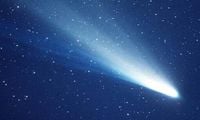The Eta Aquariids meteor shower, a celestial spectacle originating from debris of the famous Halley’s Comet, is set to peak between May 4 and May 6, 2025, offering excellent viewing conditions for astronomy enthusiasts. According to Dr. Marcelo de Cicco, coordinator of the Exoss project supported by the National Observatory (ON/MCTI), the best time to catch a glimpse of the luminous trails left by these fragments as they enter the Earth’s atmosphere will be between 2 AM and 4 AM. Observers are advised to look towards the eastern part of the sky.
One favorable aspect for viewing in early May is the absence of lunar interference. As Dr. de Cicco explains, the Moon will set before dawn until May 6, allowing for a darker sky. However, from May 7 onwards, the brightness of our natural satellite could hinder visibility of the meteors.
For those eager to witness the Eta Aquariids, it is recommended to find a location with low light pollution, away from urban lights. Settling comfortably in a reclining chair or lying on a flat surface while gazing at the lower half of the sky, directed towards the constellation Aquarius, is ideal. In the Northern Hemisphere, under optimal conditions, it is estimated that between 10 and 15 meteors may be visible per hour, while the Southern Hemisphere, particularly tropical regions, offers an even more privileged view. The longer nights and higher elevation of the radiant (the point of origin of the meteors) in the sky enhance the spectacle.
Dr. de Cicco also highlights the possibility of spotting so-called “earthgrazers”—meteors that appear long and bright, especially when the radiant is close to the horizon.
Meteor showers are luminous phenomena resulting from the entry of meteoroids—fragments of comets or asteroids—at high speeds into the Earth’s atmosphere. In the case of the Eta Aquariids, its connection to the renowned Halley’s Comet is direct. “Each meteor of the Eta Aquariids is a small piece of Halley’s Comet, which visits the Solar System every 76 years. As they enter the atmosphere, these fragments ignite, creating the characteristic light trails we observe,” explains the astronomer.
Generally small, ranging from dust particles to small pebbles, meteoroids tend to burn up quickly as they cross the atmosphere.
As the week kicks off, sky watchers have an excellent schedule ahead with the peak of the Eta Aquariids meteor shower. This phenomenon occurs when Earth passes through the densest part of the debris trail of Halley’s Comet. Each small fragment left by the comet, when entering the planet’s atmosphere at high speed, generates a meteor—commonly known as a “shooting star.” During a meteor shower, multiple fragments from the same trail hit the atmosphere. For this year, activity began on April 19 and will continue until May 28, with the maximum expected in the early hours between Monday (May 5) and Tuesday (May 6), according to the astronomical observation guide InTheSky.org.
This year, viewing conditions may not be as promising due to some interference from the Moon’s light around the peak, as it will be in the waxing phase, with 71% luminosity. Yet, the Southern Hemisphere, particularly Brazil, is in a prime position to witness the event. “Here, we normally expect between 50 and 60 meteors per hour at maximum. However, there are cases of outbreaks that can generate between 120 and 160 meteors in just one hour, although this year, the Moon’s brightness will likely hinder observations,” explains Marcelo Zurita, president of the Paraibana Astronomy Association (APA) and a member of the Brazilian Astronomical Society (SAB).
To observe the Eta Aquariids, experts recommend finding a dark place away from city lights. Lying back in a beach chair or on the ground while keeping light-emitting devices off helps the eyes adjust to the darkness of the sky. Observers should focus their attention between the middle and top of the sky. If weather conditions are favorable (with a nearly cloudless sky and minimal artificial lighting), the chances of seeing multiple meteors over one or two hours are high.
The Eta Aquariids is the first of two annual meteor showers associated with Halley’s Comet, with the second being the Orionids in October, which is less intense. All meteors from the same shower hit the atmosphere parallel to one another because they follow approximately the same orbit as the comet or asteroid from which they originated. However, due to the perspective effect, for an observer on Earth, these meteors appear to originate from the same point in the sky, known as the radiant. For the Eta Aquariids, this point is located in the constellation Aquarius, near the star Eta Aquarii, which gives the event its name.
The phenomenon is not just a visual treat; scientifically, the study of meteor showers contributes to understanding the formation of the Solar System. Each meteoroid carries information about the composition of comets, remnants of the early phases of the planetary system. These particles, upon burning in the atmosphere, release data that scientists collect through spectroscopy. The analysis of meteoroid orbits is also crucial for predicting periods of increased meteor shower intensity and for protecting satellites and space missions from potential collisions with debris.
As the peak of the Eta Aquariids approaches, astronomers encourage anyone interested to make the effort to observe this celestial event. The experience can be enhanced by using astronomy apps like Stellarium or SkySafari to locate the constellation of Aquarius and plan the observation.
In conclusion, the Eta Aquariids meteor shower not only offers a magnificent display of shooting stars but also serves as a reminder of our connection to the cosmos, as each meteor represents a fragment of a comet that has traveled through the Solar System for millennia.





